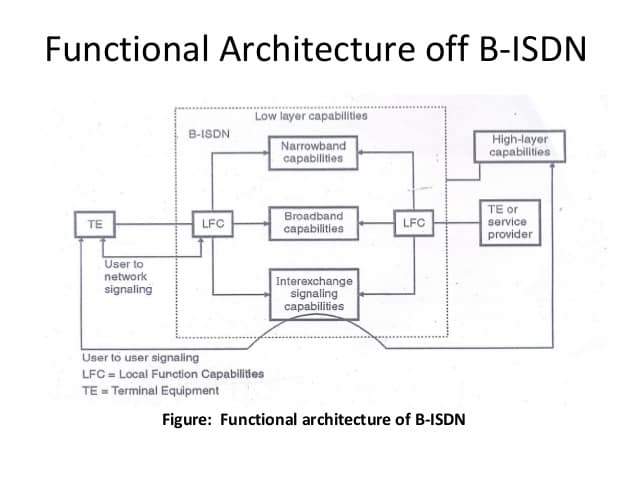B-ISDN (Broadband ISDN) is the broadband transmission counterpart of Integrated Services Digital Network (ISDN). Broadband ISDN (B-ISDN) encompasses a set of International Telecommunication Union (ITU) standards and services designed to provide an integrated digital network for audio, video, and data transmission.
This article delves into the origins of B-ISDN, explores the critical ITU-T I.150 recommendation, and examines its historical significance and technological impact on digital networking.
Table of Contents:
- What is Broadband ISDN?
- B-ISDN History
- Key Characteristics of B-ISDN
- Integration and Implementation
- The ITU-T I.150 Recommendation
- The Transition from B-ISDN to Modern Technologies
- Conclusion
- References

1. What is Broadband ISDN?
B-ISDN (Broadband Integrated Services Digital Network) is an extension of the original Integrated Services Digital Network (ISDN) standards. While ISDN was designed to digitize telecommunication networks and integrate voice and data over the same line, B-ISDN was developed to provide higher bandwidth and support a wider range of services, including those requiring high data rates like video and high-speed data transfer.
Instead of using the copper media used in ordinary ISDN, broadband ISDN uses fiber-optic and radio media. Broadband ISDN is designed to use the cell-switching transport technology of Asynchronous Transfer Mode (ATM) together with the underlying physical transport mechanisms of Synchronous Optical Network (SONET).
Broadband ISDN standards and technologies are an emerging option for high-speed networking that promises the capabilities of high-speed digital connectivity for homes and businesses.
2. B-ISDN History
Before B-ISDN, the original ISDN attempted to substitute the analog telephone system with a digital system which was appropriate for both voice and non-voice traffic. Obtaining worldwide agreement on the basic rate interface standard was expected to lead to a large user demand for ISDN equipment, hence leading to mass production and inexpensive ISDN chips.
However, the standardization process took years while computer network technology moved rapidly. Once the ISDN standard was finally agreed upon and products were available, it was already obsolete.[citation needed] For home use the largest demand for new services was video and voice transfer, but the ISDN basic rate lacks the necessary channel capacity.
Broadband ISDN Timeline
- Origins in the 1980s: The concept of B-ISDN originated in the 1980s as part of the broader movement towards digital telecommunications. The telecommunications industry was undergoing a significant transformation, shifting from analog to digital technology. This shift was driven by the growing demand for more bandwidth and advanced services, such as video conferencing and high-speed internet.
- Rise of Digital Networks: During this period, the standard ISDN was implemented to integrate voice and data services over a single digital network. However, it soon became apparent that the bandwidth offered by standard ISDN (64 Kbps per B channel) was insufficient for emerging high-bandwidth applications.
- Introduction of ATM: The development of Asynchronous Transfer Mode (ATM) technology was a key factor in the evolution of B-ISDN. ATM provided a more efficient and flexible way of handling data traffic, particularly for bandwidth-intensive applications, which was a limitation of the earlier ISDN technology.
3. Key Characteristics of B-ISDN
Broadband Capabilities
B-ISDN is characterized by its broadband capabilities, meaning it can handle significantly higher data rates compared to the standard ISDN. It was designed to support emerging applications requiring high bandwidth, such as video conferencing, multimedia services, and advanced internet services.

Asynchronous Transfer Mode (ATM)
B-ISDN is commonly associated with ATM technology. ATM is a cell-based switching and multiplexing technology that efficiently handles both real-time and non-real-time data. In B-ISDN, ATM is used to transport data in small, fixed-size packets or cells, which allows for the efficient use of bandwidth and supports the high-speed transmission of data.
Integration with ISDN Channels
- Basic Rate Interface (BRI): Standard ISDN BRI consists of two ‘B’ channels (64 Kbps each) for voice or data, and one ‘D’ channel (16 Kbps) for signaling and control. B-ISDN extends this concept by providing much higher bandwidth on the ‘B’ channels and employing ATM technology for data transport.
- Primary Rate Interface (PRI): Standard ISDN PRI in North America includes 23 ‘B’ channels and one ‘D’ channel, whereas in Europe, it’s 30 ‘B’ channels and one ‘D’ channel. B-ISDN enhances the PRI by offering a broader bandwidth range, again leveraging ATM for efficient data transport.
4. Integration and Implementation
- Backward Compatibility: One of the goals in the development of B-ISDN was to ensure backward compatibility with existing ISDN services. This meant that B-ISDN was designed to work alongside and integrate with the existing ISDN infrastructure, allowing for a smoother transition and interoperability between the two systems.
- Infrastructure and Adoption Challenges: The implementation of B-ISDN required significant upgrades to the existing telecommunications infrastructure. This included the deployment of fiber-optic cabling and new network elements capable of handling ATM traffic. Due to the high cost and complexity of these upgrades, the widespread adoption of B-ISDN was limited, and it was eventually overshadowed by other technologies like DSL, cable broadband, and fiber-to-the-home (FTTH) in providing high-speed internet access.
In summary, B-ISDN represented a significant step forward in the evolution of digital telecommunications, aiming to provide high-bandwidth, integrated services using ATM technology. Despite its technical advantages, practical challenges in infrastructure upgrades and competition from other broadband technologies limited its widespread deployment.
5. The ITU-T I.150 Recommendation
The ITU-T I.150 recommendation is a critical document in understanding B-ISDN. The International Telecommunication Union (ITU) is a specialized agency of the United Nations responsible for issues that concern information and communication technologies.
- Standardization of B-ISDN: ITU-T I.150 recommendation, titled “B-ISDN Asynchronous Transfer Mode Functional Characteristics,” was issued to provide a standardized framework for B-ISDN implementation. It outlines the functional characteristics of ATM as applied to B-ISDN.
- Key Aspects of I.150:
- Cell-Based Data Transmission: The recommendation details the use of small, fixed-size cells for data transmission, which is a defining feature of ATM. This approach allows for the efficient handling of different types of traffic (voice, video, data) over the same network.
- Quality of Service (QoS): It emphasizes the ability of B-ISDN/ATM networks to offer various levels of QoS, catering to the diverse requirements of different applications, from real-time voice and video to non-real-time data services.
- Network Architecture and Interfaces: The document also describes the network architecture for B-ISDN, including user-network interfaces and network-node interfaces, ensuring interoperability and efficient data transport.
6. The Transition from B-ISDN to Modern Technologies
The journey from B-ISDN to the plethora of modern broadband technologies we use today is a tale of rapid technological evolution and changing market dynamics. While B-ISDN marked a significant advance in digital networking, several factors contributed to its gradual eclipse by other technologies.
Economic and Practical Considerations
- Infrastructure Costs: One of the major hurdles for B-ISDN was the substantial investment required for infrastructure upgrades. Implementing B-ISDN on a large scale necessitated the widespread deployment of fiber-optic cables and ATM-compatible equipment. This was a costly endeavor compared to other emerging technologies that could use existing copper cable infrastructures, like DSL (Digital Subscriber Line).
- Complexity of Implementation: B-ISDN, with its reliance on ATM technology, was inherently complex. This complexity extended not only to the network infrastructure but also to the management and maintenance of the network. Simpler and more cost-effective solutions were becoming available that offered sufficient bandwidth for most consumer and business needs.
Technological Advancements
- Rise of DSL and Cable Internet: Technologies such as DSL and cable internet started gaining traction as they provided a more straightforward way of delivering high-speed internet over existing telephone lines and TV cable networks. These technologies were able to meet the increasing demand for broadband without the need for extensive new infrastructure.
- Evolution of Wireless Technologies: The development and expansion of wireless communication technologies also played a role. With the advent of 3G and later 4G LTE, wireless networks began offering competitive speeds, providing a flexible and often less expensive alternative to wired broadband.
- Fiber Optic Solutions: The emergence of Fiber-to-the-Home (FTTH) and related technologies offered a more direct and efficient approach to delivering high-speed broadband than B-ISDN. These technologies, while also relying on fiber optics, did not require the complexity of the ATM framework used in B-ISDN.
Market and User Demands
- Changing User Needs: The market’s needs were rapidly evolving, with a growing emphasis on internet access, streaming services, and cloud computing. The solutions that emerged were more in line with these changing demands, offering higher speeds and greater reliability without the complexities of B-ISDN.
- Global Standardization Issues: B-ISDN, while standardized by the ITU, faced challenges in global implementation. Different countries and regions had varied approaches to telecommunications infrastructure, leading to a fragmented market. Technologies like DSL and cable internet, on the other hand, found more uniform acceptance.
In conclusion, the transition from B-ISDN to the modern array of broadband technologies was driven by a combination of economic, technological, and market factors. While B-ISDN was a forward-thinking concept, the rapid pace of technological change and practical considerations steered the industry towards alternatives that better matched the evolving landscape of user needs and economic realities.
7. Conclusion
The history of B-ISDN and the ITU-T I.150 recommendation highlight the technological strides made in the field of digital networking during the late 20th century. While B-ISDN, in its original form, did not achieve widespread commercial deployment, largely due to the rapid emergence of alternative broadband technologies, its development marked a significant milestone in the evolution of network technology, particularly in establishing the groundwork for high-bandwidth digital communications and influencing subsequent telecommunications standards.
8. References
- “Data and Computer Communications” by William Stallings.
- “Telecommunications and Data Communications Handbook” by Ray Horak.
- ITU-T I.150 Recommendation: “B-ISDN Asynchronous Transfer Mode Functional Characteristics.”
- RFC 2331: “ATM Signaling Support for IP over ATM.”
- RFC 1577: “Classical IP and ARP over ATM.”
Check out, in this article, other computer networking acronyms.